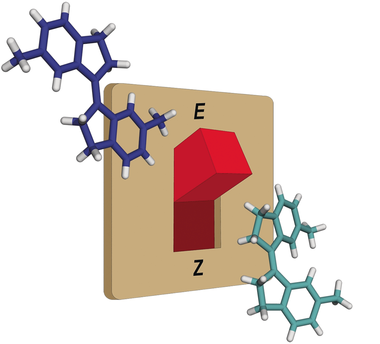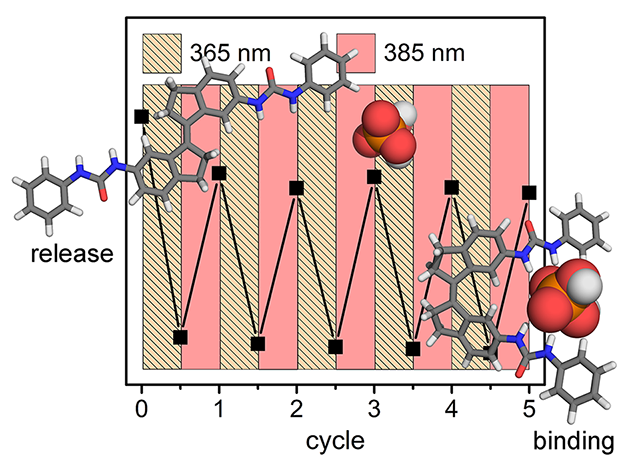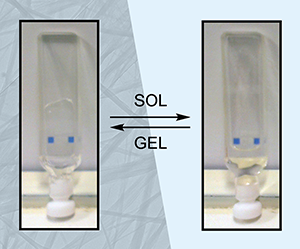Artificial Molecular Switch and Machine Development
 Artificial molecular switches and machines are widely applied to control dynamic functions, for example, through incorporation into materials and biological systems. While there are endless possibilities - beyond imagination - the toolbox is still limited and often has shortcomings. We are therefore improving the control over molecular isomerization processes, for example, by using orthogonal chemical stimuli that (un)lock photoswitching pathways. Further, we aim to optimize as well as newly discover chemically- and light-responsive switching motifs that achieve higher conversion, efficiency and robustness than currently known examples, bringing real-world applications closer.
Artificial molecular switches and machines are widely applied to control dynamic functions, for example, through incorporation into materials and biological systems. While there are endless possibilities - beyond imagination - the toolbox is still limited and often has shortcomings. We are therefore improving the control over molecular isomerization processes, for example, by using orthogonal chemical stimuli that (un)lock photoswitching pathways. Further, we aim to optimize as well as newly discover chemically- and light-responsive switching motifs that achieve higher conversion, efficiency and robustness than currently known examples, bringing real-world applications closer.
Selected key publications:
N. Duindam, et al., J. Am. Chem. Soc. 2023, 145, 21020-21026 🔗
S.J. Wezenberg, et al., Chem. Commun. 2022, 58, 11045-11058 🔗
D. Villarón, et al., Chem. Eur. J. 2021, 27, 17346-17350 🔗
Stimulus-Controlled Anion Binding and Transport
 The transport of anions across the cell membrane, which is mediated by transport proteins, is of fundamental importance to many biological processes. Dysregulation of such transport has been associated with various diseases, for example, cystic fibrosis. In this research theme we employ artificial molecular switches and machines to create anion binding and transport systems which respond to external stimuli such as light and pH change. Our main interest is to use these to influence the biological processes that are associated with transmembrane anion transport, providing a new approach to disease treatment.
The transport of anions across the cell membrane, which is mediated by transport proteins, is of fundamental importance to many biological processes. Dysregulation of such transport has been associated with various diseases, for example, cystic fibrosis. In this research theme we employ artificial molecular switches and machines to create anion binding and transport systems which respond to external stimuli such as light and pH change. Our main interest is to use these to influence the biological processes that are associated with transmembrane anion transport, providing a new approach to disease treatment.
Selected key publications:
J. de Jong, et al., Chem. Rev. 2023, 123, 8530-8574 🔗
S.J. Wezenberg, et al., J. Am. Chem. Soc. 2022, 144, 331-338 🔗
D. Villarón, et al., Chem. Sci. 2021, 12, 3188-3193 🔗
Dynamic Polymer and Self-Assembled Materials
 The supramolecular self-assembly of advanced molecular materials requires information rich building blocks that guide the growth of well-defined architectures. We are developing stimuli-responsive building blocks for self-assembling materials with programmed structures and function, which are able to change their properties in a dynamic fashion. The first succesful steps toward the preparation of metal-organic cages, frameworks and soft materials have been taken. Our eventual goal is to apply these types of materials in, for example, molecular separation, drug delivery, and regenerative medicine.
The supramolecular self-assembly of advanced molecular materials requires information rich building blocks that guide the growth of well-defined architectures. We are developing stimuli-responsive building blocks for self-assembling materials with programmed structures and function, which are able to change their properties in a dynamic fashion. The first succesful steps toward the preparation of metal-organic cages, frameworks and soft materials have been taken. Our eventual goal is to apply these types of materials in, for example, molecular separation, drug delivery, and regenerative medicine.
Selected key publications:
S. Mommer, et al., ACS Appl. Mater. Interfaces 2022, 14, 43711-43718 🔗
W. Danowski, et al., Nature Nanotechnology 2019, 14, 488-494 🔗
S.J. Wezenberg, et al., Chemical Science 2016, 7, 4341-4346 🔗